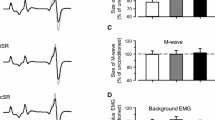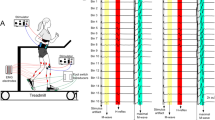Abstract
We investigated the modulation of the soleus (Sol) Hoffmann (H-) reflex excitability by peripheral sensory inputs during passive stepping using a robotic-driven gait orthosis in healthy subjects and spinal cord-injured patients. The Sol H-reflex was evoked at standing and at six phases during passive stepping in 40 and 100% body weight unloaded conditions. The Sol H-reflex excitability was significantly inhibited during passive stepping when compared with standing posture at each unloaded condition. During passive stepping, the H-reflex amplitude was significantly smaller in the early- and mid-swing phases than in the stance phase, which was similar to the modulation pattern previously reported for normal walking. No significant differences were observed in the H-reflex amplitude between the two unloaded conditions during passive stepping. The reflex depression observed at the early part of the swing phase during passive stepping might be attributed to the sensory inputs elicited by flexion of the hip and knee joints. The present study provides evidence that peripheral sensory inputs have a significant role in phase-dependent modulation of the Sol H-reflex during walking, and that the Sol H-reflex excitability might be less affected by load-related afferents during walking.






Similar content being viewed by others
References
Bastiaanse CM, Duysens J, Dietz V (2000) Modulation of cutaneous reflexes by load receptor input during human walking. Exp Brain Res 135:189–198
Brooke JD, Collins DF, Boucher S, McIlroy WE (1991) Modulation of human short latency reflexes between standing and walking. Brain Res 548:172–178
Brooke JD, Misiaszek JE, Cheng J (1993) Locomotor-like rotation of either hip or knee inhibits soleus H reflexes in humans. Somatosens Mot Res 10:357–364
Brooke JD, Cheng J, Misiaszek JE, Lafferty K (1995) Amplitude modulation of the soleus H reflex in the human during active and passive stepping movements. J Neurophysiol 73:102–111
Capaday C, Stein RB (1986) Amplitude modulation of the soleus H-reflex in the human during walking and standing. J Neurosci 6:1308–1313
Capaday C, Stein RB (1987) Difference in the amplitude of the human soleus H reflex during walking and running. J Physiol 392:513–522
Cheng J, Brooke JD, Misiaszek JE, Staines WR (1995) The relationship between the kinematics of passive movement, the stretch of extensor muscles of the leg and the change induced in the gain of the soleus H reflex in humans. Brain Res 672:89–96
Colombo G, Joerg M, Schreier R, Dietz V (2000) Treadmill training of paraplegic patients using a robotic orthosis. J Rehabil Res Dev 37:693–700
Crenna P, Frigo C (1987) Excitability of the soleus H-reflex arc during walking and stepping in man. Exp Brain Res 66:49–60
Dietz V, Duysens J (2000) Significance of load receptor input during locomotion: a review. Gait Posture 11:102–110
Dietz V, Müller R, Colombo G (2002) Locomotor activity in spinal man: significance of afferent input from joint and load receptors. Brain 125:2626–2634
Duysens J, Pearson KG (1980) Inhibition of flexor burst generation by loading extensor muscles in walking cats. Brain Res 187:321–332
Duysens J, Clarac F, Cruse H (2000) Load-regulating mechanisms in gait and posture: comparative aspects. Physiol Rev 80:83–133
Ethier C, Imbeault MA, Ung V, Capaday C (2003) On the soleus H-reflex modulation pattern during walking. Exp Brain Res 151:420–425
Faist M, Hoefer C, Hodapp M, Dietz V, Berger W, Duysens J (2006) In humans Ib facilitation depends on locomotion while suppression of Ib inhibition requires loading. Brain Res 1076:87–92
Garrett M, Kerr T, Caulfield B (1999) Phase-dependent inhibition of H-reflexes during walking in humans is independent of reduction in knee angular velocity. J Neurophysiol 82:747–753
Grey MJ, Nielsen JB, Mazzaro N, Sinkjær T (2007) Positive force feedback in human walking. J Physiol 581:99–105
Harkema SJ, Hurley SL, Patel UK, Requejo PS, Dobkin BH, Edgerton VR (1997) Human lumbosacral spinal cord interprets loading during stepping. J Neurophysiol 77:797–811
Knikou M, Conway BA (2001) Modulation of soleus H-reflex following ipsilateral mechanical loading of the sole of the foot in normal and complete spinal cord injured humans. Neurosci Lett 303:107–110
Knikou M, Schmit BD, Chaudhuri D, Kay E, Rymer WZ (2007) Soleus H-reflex excitability changes in response to sinusoidal hip stretches in the injured human spinal cord. Neurosci Lett 423:18–23
Knikou M, Angeli CA, Ferreira CK, Harkema SJ (2009) Soleus H-reflex modulation during body weight support treadmill walking in spinal cord intact and injured subjects. Exp Brain Res 193:397–407
Lavoie BA, Devanne H, Capaday C (1999) Differential control of reciprocal inhibition during walking versus postural and voluntary motor tasks in humans. J Neurophysiol 78:429–438
Marino RJ, Ditunno JF, Donovan WH, Maynard F (1999) Neurologic recovery after traumatic spinal cord injury: data from the model spinal cord injury systems. Arch Phys Med Rehabil 80:1391–1396
McIlroy WE, Collins DF, Brooke JD (1992) Movement features and H-reflex modulation. II. Passive rotation, movement velocity and single leg movement. Brain Res 582:85–93
Misiaszek JE, Pearson KG (1997) Stretch of quadriceps inhibits the soleus H reflex during locomotion in decerebrate cats. J Neurophysiol 78:2975–2984
Misiaszek JE, Brooke JD, Lafferty KB, Cheng J, Staines WR (1995) Long-lasting inhibition of the human soleus H reflex pathway after passive movement. Brain Res 677:69–81
Nakajima T, Kamibayashi K, Takahashi M, Komiyama T, Akai M, Nakazawa K (2008) Load-related modulation of cutaneous reflexes in the tibialis anterior muscle during passive walking in humans. Eur J Neurosci 27:1566–1576
Pearson KG, Collins DF (1993) Reversal of the influence of group Ib afferents from plantaris on activity in medial gastrocnemius muscle during locomotor activity. J Neurophysiol 70:1009–1017
Phadke CP, Wu SS, Thompson FJ, Berhman AL (2007) Comparison of soleus H-reflex modulation after incomplete spinal cord injury in 2 walking environments: treadmill with body weight support and overground. Arch Phys Med Rehabil 88:1606–1613
Querry RG, Pacheco F, Annaswamy T, Goetz L, Winchester PK, Tansey KE (2008) Synchronous stimulation and monitoring of soleus H reflex during robotic body weight-supported ambulation in subjects with spinal cord injury. J Rehabil Res Dev 45:175–186
Schneider C, Lavoie BA, Capaday C (2000) On the origin of the soleus H-reflex modulation pattern during human walking and its task-dependent differences. J Neurophysiol 83:2881–2890
Simonsen EB, Dyhre-Poulsen P (1999) Amplitude of the human soleus H reflex during walking and running. J Physiol 515:929–939
Simonsen EB, Dyhre-Poulsen P, Alkjær T, Aagaard P, Magnusson SP (2002) Interindividual differences in H reflex modulation during normal walking. Exp Brain Res 142:108–115
Stein RB, Thompson AK (2006) Muscle reflexes in motion: how, what, and why? Exerc Sport Sci Rev 34:145–153
Van de Crommert HW, Mulder T, Duysens J (1998) Neural control of locomotion: sensory control of the central pattern generator and its relation to treadmill training. Gait Posture 7:251–263
Zehr EP (2002) Considerations for use of the Hoffmann reflex in exercise studies. Eur J Appl Physiol 86:455–468
Acknowledgments
This study was partially supported by the Grant-in-Aid for Young Scientists (B) (No. 19700460) from the Japanese Ministry of Education, Culture, Sports, Science and Technology (MEXT) and Global COE program on “Cybernics: fusion of human, machine, and information systems” from the Japan Society for the Promotion of Science.
Author information
Authors and Affiliations
Corresponding author
Rights and permissions
About this article
Cite this article
Kamibayashi, K., Nakajima, T., Fujita, M. et al. Effect of sensory inputs on the soleus H-reflex amplitude during robotic passive stepping in humans. Exp Brain Res 202, 385–395 (2010). https://doi.org/10.1007/s00221-009-2145-2
Received:
Accepted:
Published:
Issue Date:
DOI: https://doi.org/10.1007/s00221-009-2145-2




